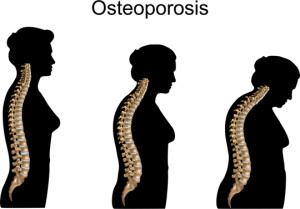What Is Osteoporosis? Understanding This Common Bone-Thinning Condition
If you're an older adult who hasn't researched the answer to the question,
It’s a question that should concern all women: “What is osteoporosis?” Yet it also should concern men, who may not be aware they also could be at risk for the disease.
What Is Osteoporosis? It Starts with an Imbalance
You may not realize that your bones—like all your body tissues—are metabolically active, and that they change as you grow, mature, and age. This change is enabled by a constant building up and breaking down of bone—a process called remodeling. In remodeling, cells called osteoclasts break down, or resorb, old bone, and cells called osteoblasts form new bone.
Up to about age 50, this system is balanced so that the ratio of new bone to old is maintained. As we get older—and particularly in women, after they go through the menopause—more bone is resorbed than is manufactured.
It’s this imbalance that underpins osteoporosis. In fact, in addressing the question “What is osteoporosis?” it’s important to note that the disease involves, literally, “porous bones” that put you at risk for osteoporotic fractures. And if you’ve already had one osteoporotic fracture, your risk for subsequent fractures increases threefold, according to research presented at the World Congress on Osteoporosis, Osteoarthritis, and Musculoskeletal Diseases in April 2016.
“Untreated osteoporosis is a public health crisis,” says Douglas P. Kiel, MD, MPH, ASBMR, president and director of the Musculoskeletal Research Center and senior scientist for the Institute for Aging Research at Hebrew Senior Life. “Many of us see firsthand the ravages of this disease every day—pain, fractures, loss of mobility and independence, and diminished quality of life.”
Are You at Risk for Osteoporosis?
Understanding your own risk factors for osteoporosis will give you a better idea of how to protect yourself—or it may ease some of your worry.
- You’re more likely to develop osteoporosis if you have a family history of the disease, are excessively thin, went through menopause before age 45, smoke, or drink alcohol to excess.
- Certain medications (such as corticosteroids, used to treat rheumatoid arthritis, and diuretics, given to treat high blood pressure) also raise the risk.
- Women who have received chemotherapy for breast cancer are at increased risk.
- Medical conditions such as celiac disease and Crohn’s disease may boost risk by interfering with calcium absorption.
Men and Osteoporosis
Nearly 1.5 million American men age 65 and older have osteoporosis, and another 3.5 million are at risk for developing it. “Women have a screening safety net,” says Mary Ruppe, M.D., a Houston Methodist endocrinologist. “Between their primary care physician and OB-GYN, women will begin getting a bone density scan at the appropriate age. Men are less likely to have routine primary care checkups and don’t receive preventative care similar to what is provided for women.”
Men should know their bone density scores start getting assessed annually for osteoporosis risk factors from age 50, according to the American College of Physicians. Things that make men vulnerable include female relatives with osteoporosis or parents who suffered a hip fracture, along with using steroids or prostate cancer drugs, gastrointestinal diseases, and excessive alcohol consumption.
The Endocrine Society recommends that all men start routine screening and receive a DEXA Scan for osteoporosis at age 70. DEXA scan results will tell you what your bone density is and if you are at risk of osteoporosis. A bone density T score roughly reflect how much bone you’ve lost—for example, osteoporosis -2.5 equates to 25 percent bone density loss, and osteoporosis -3 equates to 30 percent bone density loss.
How to Preserve Your Bone Density and Treatment for Osteoporosis
“A healthy, balanced diet combined with regular exercise and smart lifestyle choices—such as not smoking and [practicing] moderate alcohol intake—helps set the foundation for strong bones as you age,” says Judy Stenmark, CEO of the International Osteoporosis Foundation. “For those at high risk of fracture due to osteoporosis, a bone-healthy diet also supports falls prevention and enhances the benefits of therapy.
Stenmark adds that calcium should come primarily through food sources. “Supplements may be beneficial if adequate calcium intake cannot be met through the diet, especially where certain medical conditions exist,” she points out. “Anyone with concerns should speak to their doctor who can advise appropriately.”
To lessen your risk of osteoporosis, follow these common-sense tips:
- Get enough calcium. The recommended daily amount for women age 50 and older is 1,200 milligrams (mg), while men should consume 1,000 mg daily up to age 70, and 1,200 mg daily after age 71. Aim to get as much of your calcium as possible via dietary sources (e.g., milk and dairy products, fortified cereals and juices, leafy green vegetables, and canned fish).
- Take a calcium/vitamin D supplement to help make up for any dietary shortfall.
- Participate in weight-bearing exercises regularly. Examples include weight training and walking, which help to build bone.
- Avoid alcohol or drink it in moderation only. Alcohol can inhibit the absorption of calcium. The current recommendation for older adults is no more than one alcoholic beverage daily.
- Quit smoking. Cigarette-smoking is known to raise the risk for osteoporosis.
SOURCES & RESOURCES
For related reading, visit these posts:
Originally published in 2016, this post is regularly updated.



 Bone Spurs on the Spine
Bone Spurs on the Spine  Knee Injections for Osteoarthritis Pain Relief
Knee Injections for Osteoarthritis Pain Relief  What Is a Slipped Rib?
What Is a Slipped Rib? 